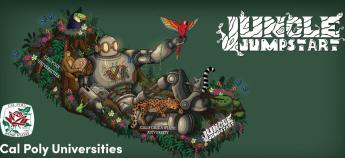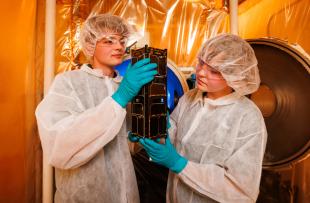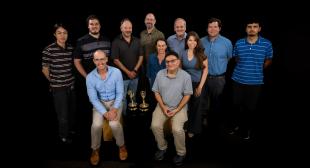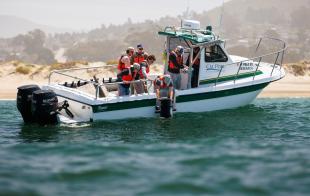Animal Engineers and Huge Robot Highlight Cal Poly Universities 2026 Rose Float Design

Cal Poly universities’ 77th Rose Parade float submission, “Jungle Jumpstart,” explores the 2026 Rose Parade theme by showcasing the dynamics between nature and technology through the story of rainforest denizens come together to restore a robot friend with what they know best — the jungle!

The sole parade float designed and built completely by students not only exudes teamwork in the way it looks but also the process by which it is constructed. Cal Poly universities’ Rose Float is a joint effort between California State University students on both the Cal Poly campus and California State Polytechnic University in Pomona, despite being separated by 250 miles.
“Our team is extremely excited to share our parade float!” said Aubrey Goings, president of the San Luis Obispo team. “It is more than just a story; it is a mirror of us, as Cal Poly university students who combine innovation, creativity and problem solving in the classrooms and labs in our day-to-day lives. We use agriculture, engineering and other disciplines in tandem.”
“Jungle Jumpstart” illustrates the beautiful outcomes that can be achieved when technology and nature work together in harmony, said Goings, a fourth-year architecture major.
The students believe audiences will be inspired by the rainforest, containing many biodiverse animals and how they collaborate to fix the robot by utilizing their specific characteristics.
“Our jungle engineers — a frog, a monkey, a jaguar and lemurs — work around the robot to bring it back to life,” she said. “They even incorporate fallen branches and plants into their repairs, symbolizing their acceptance of the robot into their ecosystem. A toucan, standing proudly atop a tree stump, is focused on the antenna of the robot, while also making sure everything below is going smoothly.
“With some inspiring teamwork, the robot flickers alive. In thanks, the robot lifts a vibrant macaw skyward, helping it take flight.”
The robot’s spare parts can also be seen, repurposed to create habitat for birds making a home in the fallen tree. These robo-parts as well as the robot’s open chest cavity also feed the diverse rainforest, creating new niches for jungle plants to survive and thrive.
Since the program’s inception in the months before the 1949 Pasadena classic — then known as the Tournament of Roses Parade — the two CSU schools have labored and designed entries that have garnered 63 awards, including the Leishman Public Spirit Award at the 2025 Rose Parade for their “Nessie’s Lakeside Laughs” float.
Cal Poly universities’ floats have also been lauded for the students’ pioneering innovations that introduced hydraulic- and computer-controlled animation to the Rose Parade.
“The program has grown a lot in the last few years, tackling many new ways to approach our float’s design,” said Amelia Atwell, president of the Cal Poly Pomona team and a fifth-year architecture major.
“Each year we grow our innovation through further integration of our disciplines’ expertise. This year, we are excited by the confidence our team is using to approach problems. We are more ready than ever to refine the processes which unite such a large cross-discipline group representing all that our Cal Poly universities offer. They are proud to show how much the program has grown, and the flex the skills they have developed in the program.”
Creating a Rose Parade float requires a year-round dedication from the two leadership teams of more than 60 students and hundreds more who assist in labs held throughout the year at each campus.
Their Learn by Doing process includes designing and building the mechanical, drive and animation systems of the float; welding the structural supports and shaping the design elements; selecting and testing decorative materials; and sheeting, foaming and painting all before the students can begin adding final floral design elements during the last week of the year.
For “Jungle Jumpstart” the team is taking on some unique challenges as they blueprint mechanisms to move float elements weighing up to 2,000 pounds, creating a 40-foot robot lying on the rainforest floor and placing individual flower petals to decorate a macaw, a colorful New World parrot, moving 25 feet in the air.
Additionally, the teams foster community by incorporating student-planned events to boost morale and designing unique “Jungle Jumpstart” merchandise to sell to supporters.
“The theme for the parade this year, ‘The Magic in Teamwork,’ presents a very exciting challenge for our team,” Goings said. “When this theme was announced, we immediately related to it, as it perfectly describes what we do each year: come together across campuses to design and fabricate something magical. Not only do we create something physically beautiful each year, but the program also unites us as a family through our teamwork processes.
“The float may only be completed for one single day, but the experiences and relationships we foster will persist over many years.”
“Jungle Jumpstart” will use a wide array of materials that capture the mystery of the rainforest. Carnivorous plants will be among the elements providing splashes of vivid tropical colors, as will alstroemeria (lily of the Incas) and liatris (blazing star). The robot will be festooned with a blend of blue corn grits and silvery-gray dusty miller (Senecio cineraria) accented with patches of two-tone high and magic roses that echo the jungle’s lush palette of greens, reds and yellows.
“I think this is going to be the most thematically beautiful float that we have done within the last four years,” said RJ Pollock, assistant design chair and journalism major. “From the story we are trying to tell, to the elements, to the passion, the creativity, and colors, I think this will be one of the most visibly stunning floats in our program.”
Want more Learn by Doing stories in your life? Sign up for our monthly newsletter, the Cal Poly News Recap!




